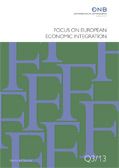Focus on European Economic Integration Q4/21
 OeNB
OeNB
- Erschienen:
- November 2021
 OeNB
OeNB
Call for applications: Klaus Liebscher Economic Research Scholarship (PDF, 61 kB) en 30.11.2021, 00:00:00
Developments in selected CESEE countries (PDF, 1,4 MB) en 30.11.2021, 00:00:00
Outlook for selected CESEE countries and Russia (PDF, 281 kB) en 30.11.2021, 00:00:00
Green transition: what have CESEE EU member states achieved so far? (PDF, 741 kB) Breitenfellner, Lahnsteiner, Reininger, Schriefl. Scientific evidence and political commitments require decisive measures to both mitigate and adapt to climate change. This stock-taking exercise sheds light on the green transition to climate neutrality in Central, Eastern and Southeastern Europe (CESEE), comparing the EU members in CESEE in the aggregate with the group of other EU countries. Over the last three decades, CESEE economies have converged substantially to EU averages with respect to both carbon intensity and income per capita – on the back of their profound and painful restructuring process mainly in the first decade of their transition to market economies. Analyzing the development of greenhouse gas emissions in CESEE from 1990 to 2018, we find that energy intensity dropped markedly, the share of transport sector emissions increased sharply and reliance on coal, while still substantial, declined. Industry electricity prices before taxes in CESEE are roughly on a par with the EU average, but household energy prices before taxes are still moderately lower in nominal – but clearly higher – in real terms (adjusted for income levels). At the same time, (implicit) CO2 prices are below EU average levels. Comparing EU member states’ climate policy commitments, we find that both the CESEE and the other EU members are very likely to have met the long-standing targets for 2020 on aggregate, with the targets for the CESEE region having been relatively modest. We conclude that despite their still lagging behind somewhat, CESEE economies are generally well positioned to advance their green transition at relatively low costs and to compete for market shares in green industries. However, all EU member states must step up their efforts in the coming years to have a reasonable chance of reaching their net-zero emission target in 2050 and the intermediate target to reduce net emissions by 55% up to 2030. Our assessment is relevant for the ongoing drive in the EU to mobilize finance for sustainable growth – a drive which involves central banks and supervisors in banks’ home and host countries. en climate change, low-carbon transition, economic development, environmental sustainability; Central, Eastern and Southeastern Europe O1, O52 Q54, Q56 30.11.2021, 00:00:00
Which borrower in CESEE gets which loan? Evidence from the OeNB Euro Survey (PDF, 749 kB) Bittner. This paper sheds light on the distribution of three types of retail loans as well as their drivers in ten countries of Central, Eastern and Southeastern Europe (CESEE). Based on data from the OeNB Euro Survey, the study aims at analyzing the characteristics of individuals taking out loans for (1) housing, (2) consumption or (3) education, business or professional activities and other purposes. Logistic regression is used to analyze average marginal effects of a variety of independent variables, such as sociodemographic factors, (economic) attitudes and expectations, trust in institutions, and financial literacy. Identifying and understanding characteristics of borrowers holding certain types of loans may inform the formulation of microprudential policies and thus help promote financial stability. Apart from being married, trusting domestic banks and the EU as well as having an internet connection at home, having earned income is very important for all three types of loans, with the level of personal income impacting on housing loans only. Borrowers’ level of education is a key driver of both housing loans and loans for education, business or professional activities and other purposes, and less so of consumer loans. High inflation expectations have a significant impact on consumer loans as well as on loans for education, business or professional activities and other purposes. Depending on the loan type, the number of significant drivers differs greatly. en types of loans, key drivers, CESEE, survey data, average marginal effects D12, D14 30.11.2021, 00:00:00
88th East Jour Fixe (PDF, 141 kB) Household financial vulnerabilities in CESEE: what impact has COVID-19 had and how to best measure the changes? en 30.11.2021, 00:00:00
26th Global Economy Lecture (PDF, 265 kB) Partha Dasgupta on “Viewing the future from the population-consumption-environment nexus” en 30.11.2021, 00:00:00
Statistical annex (PDF, 188 kB) en 30.11.2021, 00:00:00